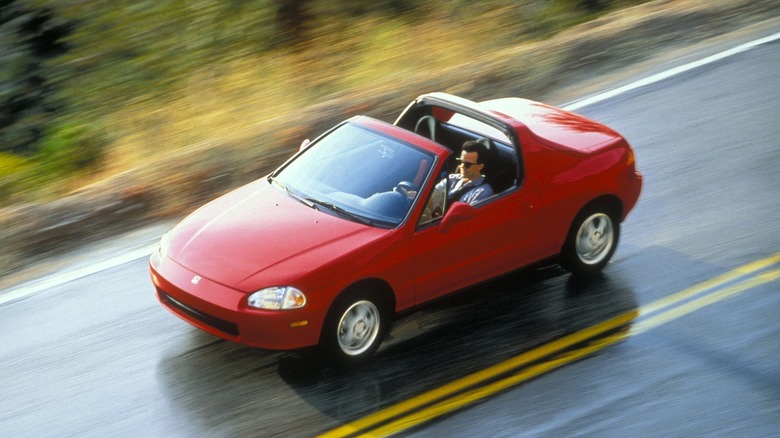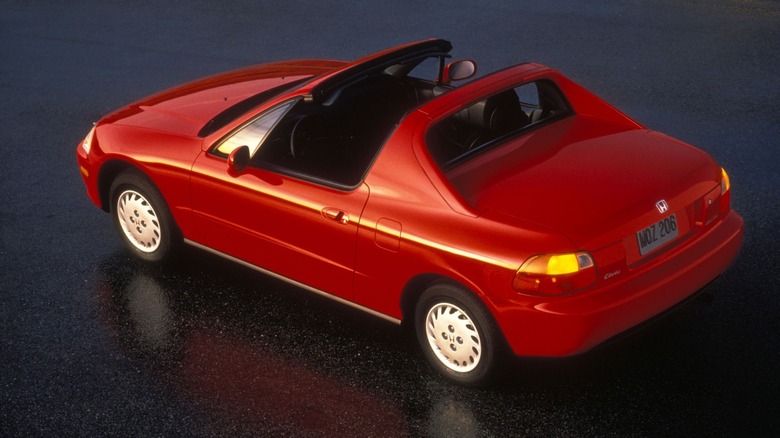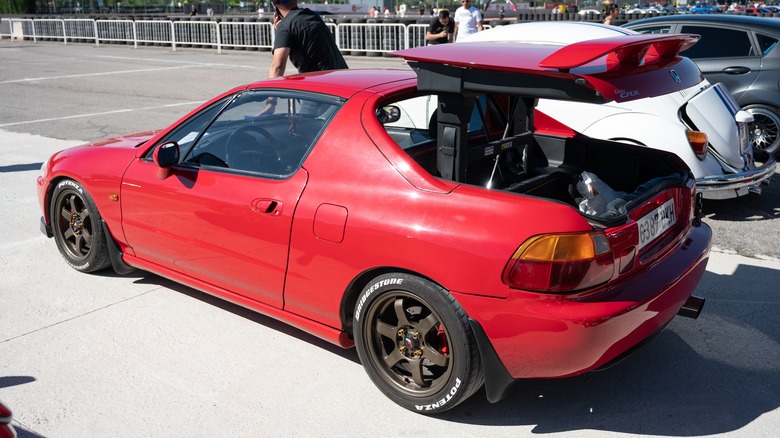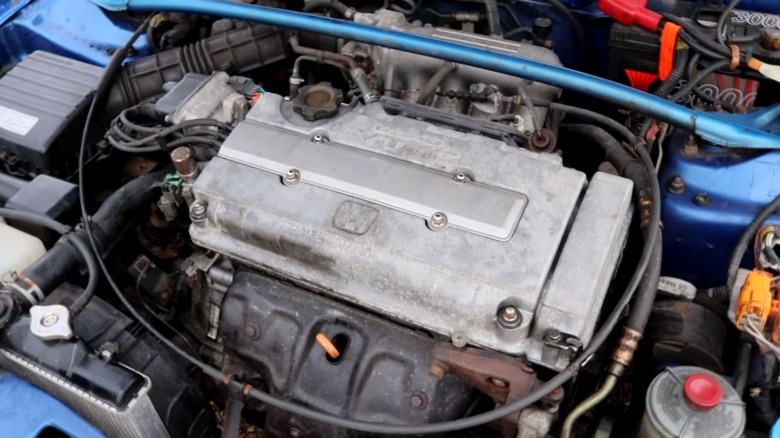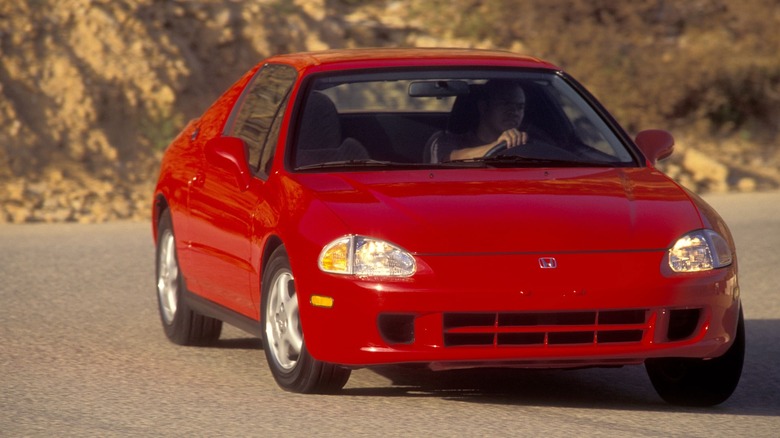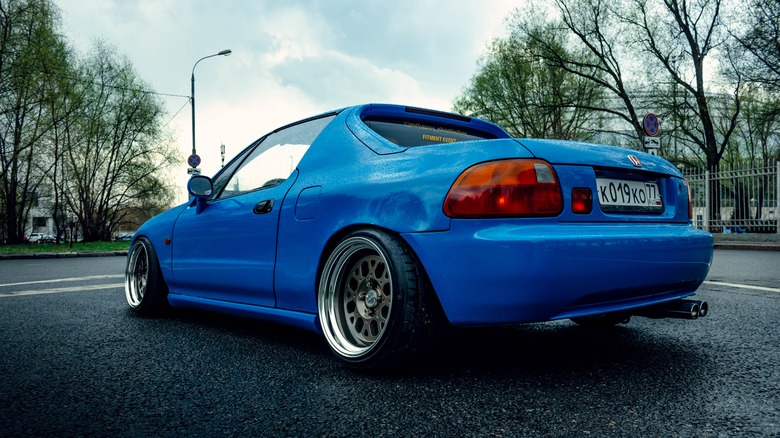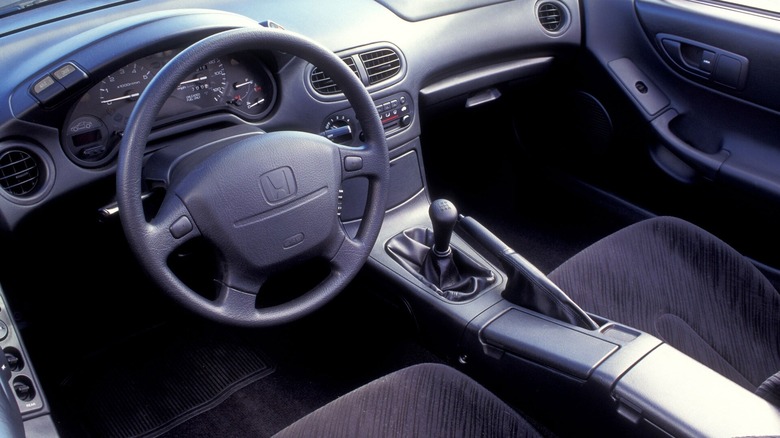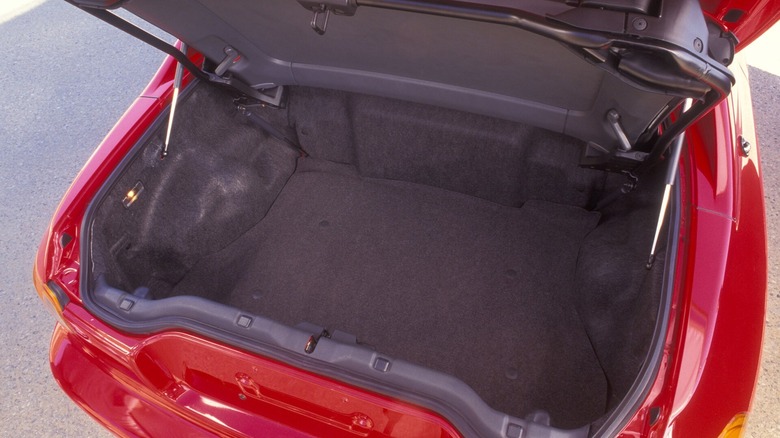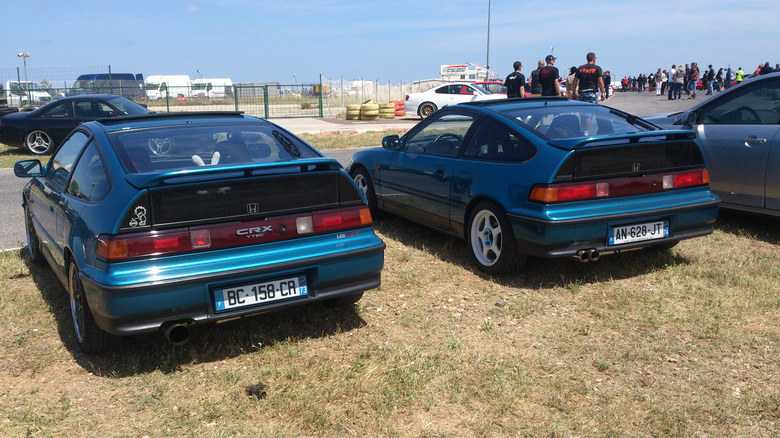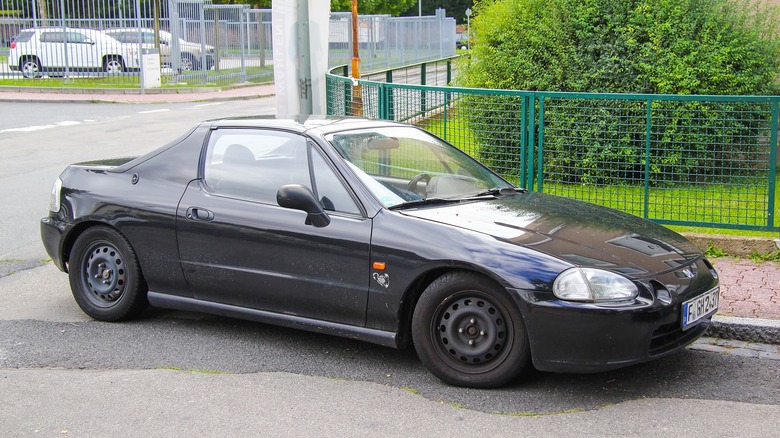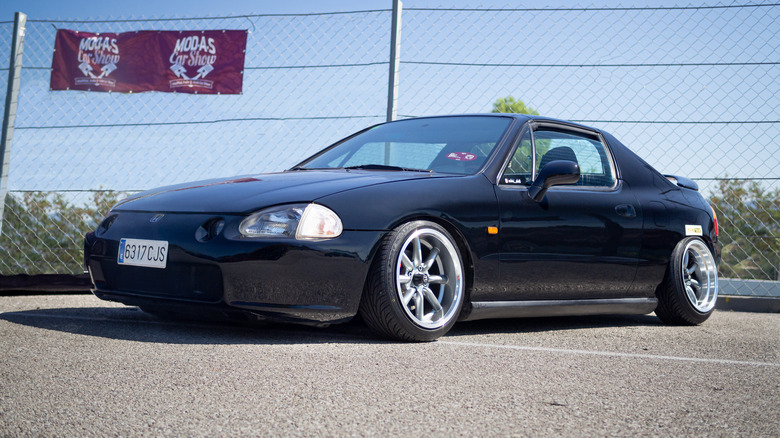The 10 Coolest Features Of The Honda Del Sol
The 1990s were something of a boom decade for sports cars, with so many excellent models launching that it's easy to forget some of them. The Honda Del Sol, or Civic Del Sol as it was also known, is one such car, as it can sometimes be overlooked in favor of the ever-popular Mazda MX-5 Miata. The Del Sol was launched as a direct rival to the Miata, but rather than being built from the ground up as a sports car, it was based on the bones of the regular Honda Civic hatchback (via Motor1).
It was far from a perfect car, with Motor1 noting that some models suffered from build quality issues, and there were complaints about the interior fit and finish and the relative lack of gadgetry compared to its competition. These complaints dampened enthusiasm for the Del Sol, and it was retired in the U.S. in 1997 due to low sales. It looked set to be consigned to the history books, but a recent resurgence in interest in Japanese cars from the '80s and '90s has brought the Del Sol back into the spotlight and kept interest in Honda's plucky little sports car going strong. There's plenty to like about the Del Sol, even if it never achieved the same level of recognition as its arch-rival, the Miata.
Targa top for America
The name "Del Sol" literally translates from Spanish as "of the sun," which alludes to its removable targa top (via Lane Motor Museum). All American-market Del Sols featured the same targa top, which Honda paired with a retractable rear window to give the feeling of driving a convertible. The roof had to be removed by hand and then stored in the trunk, meaning drivers had to pull over to get the roof back out if the weather turned while they were driving.
The "targa" name began in 1966 with the Porsche 911 Targa, and Porsche still retains the trademark to the word. Mazda eventually released a targa top Miata in 2016, but back when the Del Sol first hit the market, the Miata was still only available as a roadster. Targas were just hitting peak popularity when the Del Sol was released, with the Chevrolet Corvette, Ferrari F355, and Nissan 300ZX also offering the unusual roof layout (via The Verge and Garage Dreams).
TransTop for Europe and Japan
American Del Sol buyers were stuck with the targa top whether they liked it or not, but in Europe and Japan, another option was available: the TransTop. This strange mechanized contraption has been called "the most baffling convertible top ever made," due to its unique way of attaching and removing the roof. To take the top off, a box rises from the trunk to the level of the roof. Then, two robotic grabbing arms reach out and take the targa-like section of the roof and drag it back into the box. The whole contraption then descends back into the trunk, with the lid of the trunk closing behind it.
It's a tricky process to visualize, but seeing it in action really demonstrates how odd this whole process is. It's not clear why Honda chose not to bring the TransTop Del Sol to America, but now that earlier model year cars have become old enough to be imported under the 25-year rule, a few have made it Stateside anyway.
Inline-four VTEC engine
The Del Sol shared its engine options with the regular Civic, with base-spec S trims getting a 106 horsepower, 1.6-liter engine. Mid-spec Si trims used the same engine, but with a slight power bump to 127 horsepower, and top-spec VTEC trims gained an extra 33 horses on top of that (via Honda). Honda's VTEC technology was cutting-edge at the time, and it helped give the top-spec Del Sol's engine the highest horsepower-per-liter rating of any naturally aspirated engine on sale (via Cars). This is also where one of the Del Sol's biggest marketing flaws came in: Despite the top-spec trim being called the VTEC, mid-spec Si trims also got an engine with VTEC technology, albeit a less powerful one.
This reportedly led to some confusion among customers over the difference between VTEC the trim and VTEC the engine technology, although it's not clear how much this mixup affected potential sales. Aside from the confusing naming, the car's lineup of relatively ordinary engines did bring one major advantage for owners: They were as easy as a regular Civic to service, and parts were also readily available, helping keep costs down over the long run.
Nimble handling
The Del Sol's Civic underpinnings also meant that it handled similar to its best-selling lineup sibling, with reviewers calling it "light, nimble, [and] almost racecar-like" to drive (via NewCarTestDrive). It wasn't fast by any stretch of the imagination, as 0-60 mph took nearly eight seconds, which was actually slower than the Civic on which it was based (via Honest John Classics). Even so, the car's high redline meant that pushing the Del Sol to its limits was very rewarding, with the engine finding most of its power towards the top half of the tachometer.
The car didn't feel quite as sharp to drive as some of its rivals, but its predictability made it a good bet for drivers who, as Honest John Classics put it, might have found the Miata "a bit too hairy chested." It straddled the line between feeling like a traditional convertible sports car and a regular Honda Civic, and to its many fans, that gave it a unique appeal that almost nothing else on the market offered at the time.
A sports car for the city
When the car made its American debut in 1992, The New York Times predicted that "city dwellers [were] going to love it," as it came with a number of features that made it more easily daily drivable than other sports cars of its era. One such feature was the sliding panel in the middle of the dash that hid the radio from would-be thieves, preventing theft when the vehicle was left roofless and unattended. Its highway manners were also complimented by the NYT, with the reviewer noting that the car was quiet both with the roof on and roof off.
The dash also featured a green light to notify drivers that the back window of the car was still open, helping to prevent them from putting the roof on and then leaving the car partly exposed. It seemed like Honda had designed the Del Sol with urban environments in mind, and its helpful dash notifications made it easier to live with in colder climates than the likes of the Miata. Perfect, in other words, for a city like New York, where both radio theft and snowy winters were a perennial problem.
Comfortable bucket seats
The interior of the Del Sol was designed with just as much Japanese practicality as Honda's other models, with a straightforward, easy-to-read dash layout and most of the furnishings transferred over from the best-selling Civic. The seats, however, were unique to the Del Sol, and they were a particular highlight of the car. They were quite thin even by sports car standards, but they were carefully molded to fit a driver's body and featured enough padding to make them comfortable for longer journeys (via The New York Times).
Some examples came with stripes down the middle of the seats, giving them a much sportier look than the car's rivals. Some have even claimed the design made them look aftermarket, certainly in comparison to seats from rival sports cars like the Miata and the Mercury Capri. The Del Sol might not have been the fastest car in its segment, but for longer trips, it was certainly one of the comfiest.
Spacious for a sports car
Going on longer trips was also made easy thanks to the car's fairly generous luggage space, at least for a sports car. The trunk also housed the locking rack where the roof panel lay when not in use, and the car's two token back seats weren't much good for adult passengers but were ideal for fitting in a few extra bags of groceries (via Deseret News). Cabin storage space was also generous, with a slightly cramped glovebox, but plenty of bins and cubbies to make up for it (via The New York Times).
Again, this mattered less to the would-be Miata buyer who just wanted to have fun on the open road, but it gave the Del Sol a unique sense of practicality that appealed to urbanites looking for a sporty daily driver. The Del Sol wasn't the only sports car of its time to feature two small rear seats — both the Nissan NX 2000 and Mazda MX-3 also featured similar layouts — but it was arguably the best at combining both plentiful trunk space and room for four passengers.
The successor to the CR-X
Part of the reason that customer expectations for the Del Sol were so high is that it was directly replacing the much-loved Civic CR-X. The sporty CR-X Si debuted in 1985, and quickly established itself as one of the most fun-to-drive cars in its price bracket, even if it only had 91 horsepower on tap (via Road and Track). Its five-speed transmission encouraged drivers to row through the gears as often as possible, and its lightweight and stiff suspension helped cut body roll to a minimum.
The CR-X was discontinued in 1991 in preparation for the Del Sol, much to the disappointment of the car's many fans. Replacing what's been billed as one of the greatest Hondas of all time was going to be tricky, to say the least, and it's in this context where the Del Sol was termed a disappointment by some. It wasn't as light or as agile as its predecessor, despite the fact that, in its own right, it was still a fun car to drive overall. Ironically, the Del Sol's connection to one of Honda's greatest sporty cars was also arguably the reason that it never made the commercial impact that the company was hoping it would.
Cheap used price
The lingering effects of this mixed reputation have had one positive side effect for fans of the car: It's kept resale prices very affordable. While other sports cars from the '90s have shot up in price as JDM nostalgia has hit record highs, the Del Sol hasn't been affected too much, with examples still available in working order for around $10,000. Most examples will no longer be in showroom-worthy condition seeing as they were never considered "collectors' cars" in the first place, but that shouldn't matter to used buyers. After all, the Del Sol isn't valuable enough to consider keeping it as a garage queen — they're very much bought to be driven.
It's been argued that even a modest five-figure price tag is still too much to pay for the car, considering that at the end of the day, this is a 30-year-old Honda that's based on a Civic and doesn't boast the same reliability record that many other Japanese cars from the era do (via MotorBiscuit). But, Del Sols in good running condition are getting trickier to find, and as they get rarer, it's likely that their price will increase even further.
Extensive aftermarket
Part of the reason that Del Sols are getting increasingly trickier to find in original condition is that they're popular cars to modify, as their Civic underpinnings mean that there's an extensive aftermarket available. Up until fairly recently, they've also been available to buy for just a few thousand dollars, making them ideal for younger, more cash-strapped enthusiasts. While the Del Sol's popularity with this crowd has undoubtedly been one of the driving forces keeping demand for the car alive, it's also meant that many examples have been lost to accidents or poor-quality modifications.
Perhaps, ironically, the few surviving mint condition examples of the Del Sol will see their values dramatically increase within a few years, as collectors realize there simply aren't many left. More likely, however, is that the car will continue to be appreciated by owners and fans, remaining stuck with the label of being one of many competitors that couldn't quite match up to the Miata.
